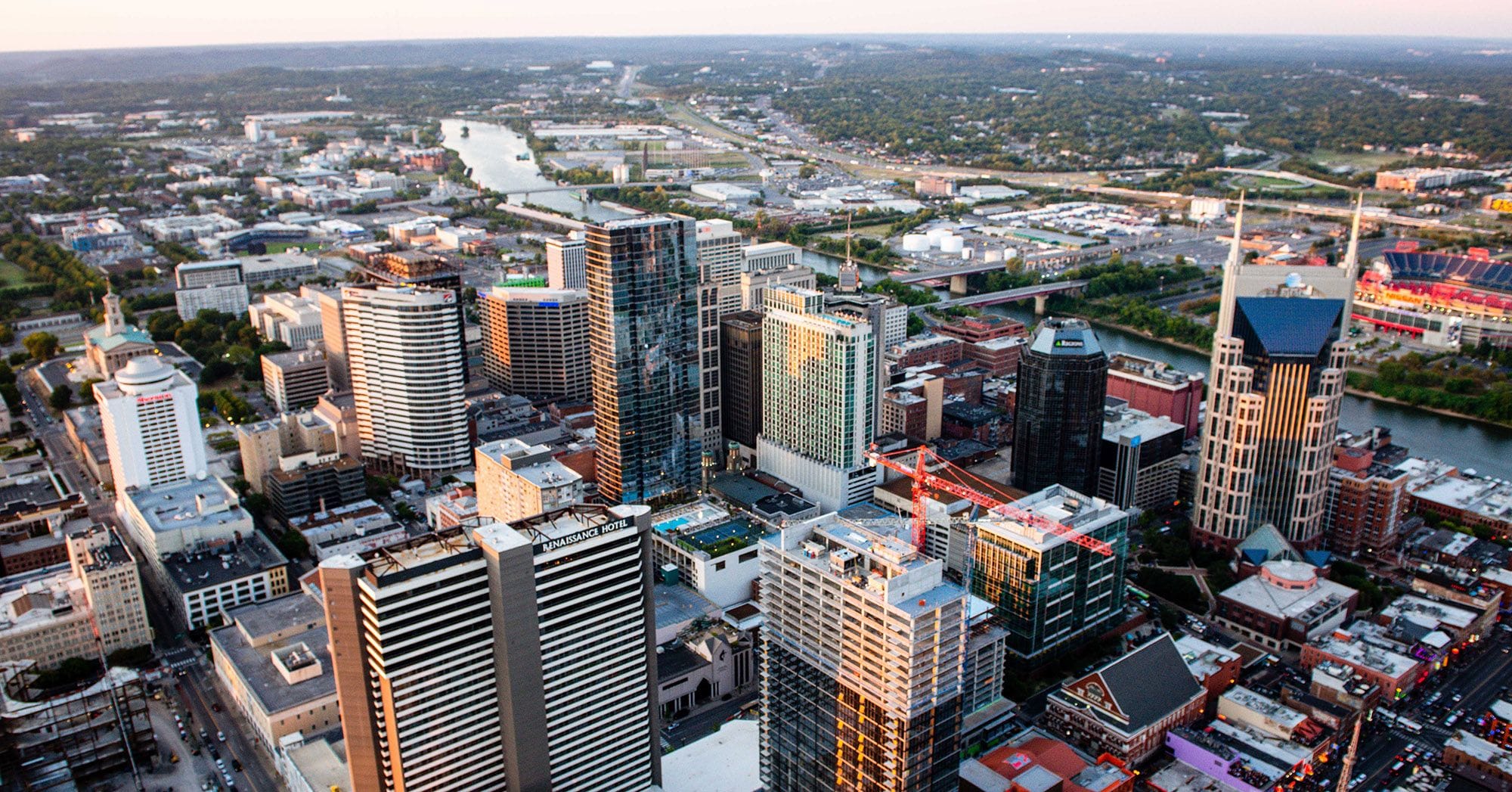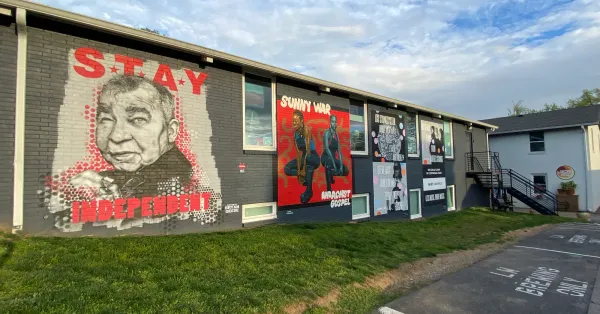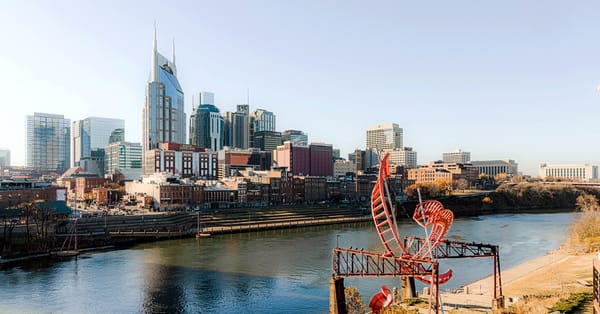The population growth in Nashville is undeniable. If you’re local to the area, chances are, you’ve seen this growth first-hand. If you’re considering a move to Nashville, you’ve likely considered how population growth will affect your move in terms of rent or property prices, or cost of living.
In the sections below, we’ve organized the answers to questions such as these, and more, so you can go into your move to Music City equipped with helpful statistics and ensure a smooth transition.
Table Of Contents
- How Many People Move To Nashville A Day?
- How Many People Are Moving Out Of Nashville Per Day?
- Where Are People Moving From?
- How Does This Compare To Other Cities?
- How Does This Growth Compare To Nashville's Growth Historically?
- What's Causing Nashville To Grow?
- How Has The Growth Affected The Nashville Area?
How Many People Move To Nashville A Day?
Nashville is one of the fastest-growing cities in the country. According to data from the US Census Bureau from 2020 to 2021, Nashville had a population of 689,454 which was an increase of 13,234 residents from the previous year.
This means that around 36 people per day moved to Nashville during that time.
How Many People Are Moving Out Of Nashville Per Day?
While Nashville had steady growth between 2020 and 2021, more recent data from the US Census Bureau has shown that Nashville has taken a small dip in population since then — about a 0.8% drop.
More specifically, the 2022 US Census findings estimated that the population in Nashville was around 683,622 people for that year meaning that around 16 people left Nashville per day between 2021 and 2022.
While there was technically a decrease in residents in Nashville, the overall trend still remains the same when compared to previous years – Nashville is growing.
Where Are People Moving From?
Gauging where people come from before moving to Nashville can be a tricky process and relies heavily on long-term data from the US census.
While we may not know where people are moving from in 2023, we do know that between 2011 and 2015, most people moving to Nashville domestically moved from other areas of the state – around 10% of the total recorded incoming residents.
Out of the top ten areas that people move to Nashville from, four of them were cities in Tennessee:
- Knoxville: Approximately 3,073 people moved to Nashville from Knoxville
- Memphis: Approximately 3,046 people moved to Nashville from Memphis
- Clarksville: Approximately 1,829 people moved to Nashville from Clarksville
- Chattanooga: Approximately 1,150 people moved to Nashville from Chattanooga
Additionally, most of the new residents to Nashville during this period moved from within the southeastern US. These include cities such as:
- Atlanta: An estimated 2,244 new Nashville residents moved from Atlanta
- Washington, DC: An estimated 1,173 new Nashville residents moved from Washington, DC
- Miami: An estimated 1,170 new Nashville residents moved from Miami
Among the non-Southeastern residents that moved to Nashville during this period, most of them moved from Chicago (2,130 residents), New York City (1,474 residents), and Los Angeles (1,284 residents).
Nashville is well-known for its diversity, and there is substantial evidence to prove that. There were slightly more international immigrants to Nashville than there were domestic transplants during this period – around 11.5% of total new residents, most of which immigrated from Asian countries.
How Does This Compare To Other Cities?
While Nashville had a slight decrease in population in the last census tally, it’s been consistently listed as one of the country’s fastest-growing cities and shows no signs of slowing down in the long run.
According to a projection published by the Washington D.C.-based economic and demographic data firm Woods & Poole Economics, Inc., Nashville will likely be among the country’s most populous cities by 2060.
The study projects Nashville reaching a population of 3,182,500 people by 2060 – a 56% increase from the current population.
If population growth follows this trend, Nashville will be ranked 31 among the nation's largest metropolitan areas.
How Does This Growth Compare To Nashville's Historic Growth?
As stated many times throughout this article, Nashville has been on an upward trajectory population-wise for several decades. Below, we’ve listed out Nashville’s population by decade to give you an idea of the impressive growth that has taken place here over the years.
As you can see, Nashville has undergone considerable growth in the past 100 years. According to the US Census, there was only one decade between 1920 to 2020 where there was a decrease in population; 1960 — a -2% decrease. However, in the following decade, Nashville saw its largest population growth to date — a massive 162.2% growth.
What’s Causing Nashville To Grow?
There are many possible reasons for the extensive growth of Nashville’s population. Below, we’ve highlighted a few of the main factors that make Nashville one of the most popular places to move to.
The job market
Nashville’s economy is worker-friendly. Apart from the huge spike in the worldwide unemployment rate during the 2020 pandemic, Nashville’s unemployment rate has steadily been decreasing since 2009.
This, coupled with the fact that jobs have been increasing in Nashville for the last several years, has made Nashville an incredibly desirable area to settle. In fact, Nashville ranked number six in the nation for job growth in 2022, according to the Nashville Chamber of Commerce.
Real estate
While the real estate market is currently somewhat competitive nationwide, Nashville’s real estate market has stayed relatively stable for the past several years compared to other cities.
While you may not be able to buy a house for less than the national average, it’s good news for people who are looking to settle long-term as people who buy houses in Nashville always get a fantastic return on their investments.
Music, arts, food, history, and activities
It’s well-known that Nashville is not a boring place to live, and many people consider it to be one of the most culturally enriching destinations in the country.
In Nashville’s downtown areas, you can easily find engaging museums, such the Country Music Hall of Fame and the Tennessee State Museum, heart-stopping music venues such as The Grand Ole Opry and Bridgestone Arena, artistic points of interest such as The Parthenon and the Frist Art Museum, and critically acclaimed restaurants that are sure to make your mouth water such as The Catbird Seat and The Continental — all within just a few city blocks.
While some prefer a more quiet place in the country, there are plenty of people who are drawn to the enlivening lifestyle that Nashville has to offer.
How Has The Growth Affected The Nashville Area?
Growth can have both positive and negative effects to any given area. In Nashville, growth has resulted in a number of changes, affecting both its residents, as well as the country at large.
Below are a few examples of how Nashville has changed with population growth and what it means for the future of the city.
Jobs
As more people move into a given area, more jobs are typically created to serve the needs of the growing population.
More people means more schools, hospitals, restaurants, and infrastructure are needed, and within all of these industries, residents will have greater access to more employment in order to meet the demands of a growing community.
This same rule of thumb applies to Nashville, and as mentioned earlier in this article, jobs have never been more accessible. In 2022, Nashville was ranked number six in the nation for job growth. This growth in job accessibility is directly affected by the massive number of people migrating here every year.
Real estate and rental costs
The cost of rent and real estate in relation to population growth, however, is a little more complicated. More people moving into an area means that there will be more demand for housing. If supply can keep up with demand, the cost of rent and real estate will generally stay the same.
However, if an influx of population supersedes a city’s ability to build housing fast enough, the cost of rent and homes could go up.
The bad news for renters nationwide is that rent has consistently skyrocketed nationally since 1940 alongside population growth in the US. However, the good news is that the cost of Nashville rental prices has stayed below or on par with national rent costs for the past several years.
While this is a seemingly small win for Nashville renters, it’s important to note that Nashville has had above-average population growth for some time in comparison to nationwide growth while still keeping rental prices modest.
The cost of real estate in Nashville, however, tells a different story.
While the cost of real estate has consistently gone up in the last several years both nationwide and in Nashville, the homes for sale in Nashville are selling at a slightly above-average price.
While in the short-term this can be a letdown for those looking to relocate to the area, on the other hand, long-term residents can expect to get a good price on their home when it comes time to sell.
Cost of living
Similarly to real estate and rental prices, the cost of living in relation to population growth is directly affected by supply and demand.
If the supply of goods such as groceries and cleaning supplies, and services such as bars, restaurants, and entertainment start to dwindle with the demand of population growth, the cost of these goods and services will become more expensive.
However, if you’re planning a move to Nashville, chances are, you won’t see much of a difference in the cost of living.
According to PayScale, the average cost of living in Nashville is slightly below the national average, meaning that population growth hasn’t affected the cost of living in Nashville as it has in many other places nationwide.












